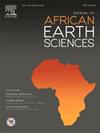伊拉克南部祖拜尔油田侏罗纪演替的构造演化和构造地质学
IF 2.2
4区 地球科学
Q2 GEOSCIENCES, MULTIDISCIPLINARY
引用次数: 0
摘要
本研究利用三维地震反射数据,对伊拉克南部祖拜尔油田内侏罗系演替的构造样式和构造演化进行了研究,这些构造样式和构造演化对于向白垩系储层充油至关重要。该油田位于伊拉克南部阿拉伯板块东北部的美索不达米亚平原。已确认的褶皱有四个:哈马褶皱、舒艾巴褶皱、拉夫迪亚褶皱和萨夫万褶皱,每个褶皱都由特定的地球动力过程形成。Hammar、Shuaiba 和 Safwan 是与盐有关的褶皱,受到盐构造的影响。拉夫第亚被确定为与压缩有关的褶皱,是由于阿拉伯板块和欧亚板块交汇而形成的。已确定的断层有 47 个,其多样性模式和空间分布表明其构造历史分为三个不同阶段:伸展构造、与盐活动同时发生的伸展构造以及板块汇聚。这些阶段形成了一系列地堑结构,与已发现的褶皱一起,凸显了三个主要构造过程的作用:基底构造、盐动力学和板块相互作用在侏罗纪时期塑造了祖拜尔油田的构造风格。本文章由计算机程序翻译,如有差异,请以英文原文为准。
Tectonic evolution and structural geology of the Jurassic succession in the Zubair oil field, southern Iraq
This study investigates the structural style and tectonic evolution of Jurassic succession in southern Iraq, within the Zubair oil field, which are crucial for charging oil to the Cretaceous reservoirs, utilized 3-D seismic reflection data to explore its complex geological history. The field is located in the Mesopotamian plain on the northeast Arabian Plate in southern Iraq. Four folds recognized: Hammar, Shuaiba, Rafdyia, and Safwan, each shaped by specific geodynamic processes. Hammar, Shuaiba, and Safwan are characterized as salt-related folds, influenced by salt tectonics. Rafdyia is identified as a compression-related fold formed due to the convergence of the Arabian and Eurasian plates. Forty-seven faults were identified, with diversity patterns and spatial distributions suggesting a tectonic history marked by three distinct phases: extensional tectonics, extensional with concurrent salt activity, and plate convergence. These phases have created a series of graben structures that, along with the identified folds, highlight the role of three primary tectonic processes: basement tectonics, salt dynamics, and plate interactions in shaping the structural style of the Zubair oil field during the Jurassic time.
求助全文
通过发布文献求助,成功后即可免费获取论文全文。
去求助
来源期刊

Journal of African Earth Sciences
地学-地球科学综合
CiteScore
4.70
自引率
4.30%
发文量
240
审稿时长
12 months
期刊介绍:
The Journal of African Earth Sciences sees itself as the prime geological journal for all aspects of the Earth Sciences about the African plate. Papers dealing with peripheral areas are welcome if they demonstrate a tight link with Africa.
The Journal publishes high quality, peer-reviewed scientific papers. It is devoted primarily to research papers but short communications relating to new developments of broad interest, reviews and book reviews will also be considered. Papers must have international appeal and should present work of more regional than local significance and dealing with well identified and justified scientific questions. Specialised technical papers, analytical or exploration reports must be avoided. Papers on applied geology should preferably be linked to such core disciplines and must be addressed to a more general geoscientific audience.
 求助内容:
求助内容: 应助结果提醒方式:
应助结果提醒方式:


